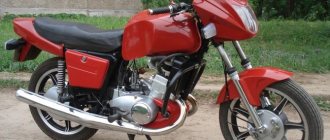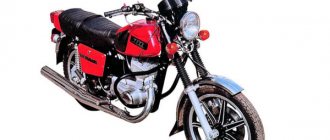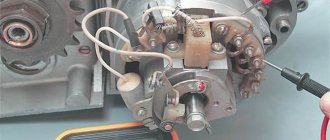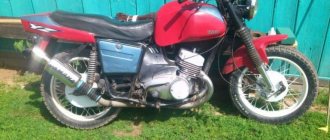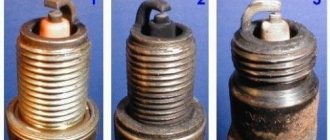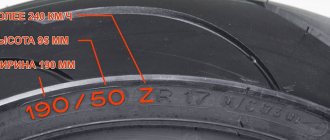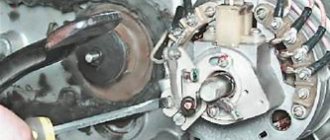Motorcycle "Planet-5"
The Planet-5 motorcycle, production of which began in 1985 and was completed in 2008, is remarkably amenable to tuning. More often they carry out tuning of the exterior, some units or main components. To make the fifth “Planet” more playful and passable (in fact, convert the IZH “Planet-5” into a cross-country motorcycle), they remove excess from the frame in order to reduce the 180-kilogram weight of the motorcycle when it is loaded. Then, for better ride, long-stroke shock absorbers are installed on the rear wheel and the front fork is replaced. You can rearrange it from a Java motorcycle with increased speed. Naturally, the wings are also changed.
There are no major changes to the engine. To increase the service life of the crankshaft, replace the original bearings from the secondary shaft with “Java” ones. The quality and increased service life compensate for the high cost of these bearings.
For the IZH Planet-5 motorcycle, engine tuning also means increasing the cylinder volume. To do this, the top is cut off and the sleeve is bored to 76 millimeters. A piston from Planet-Sport will fit freely under this size. After these modifications, the prototype of the modernized Planet 5 will reach a speed of up to 160 kilometers instead of its 120 kilometers per hour. By the way, on the test bench the engine developed a power of 42 hp. at 5950 rpm. But with any boost of the engine, its resource is reduced. Such modifications should not be made on a motorcycle intended for everyday normal riding.
When boosting the engine, the standard rear tires, clutch and chain may not last long. We need to think about their modernization.
Izh motorcycles: how it all began
The other day, fans of domestic motorcycles celebrated their anniversary - 90 years ago, on September 17, 1929, the first Izh motorcycles were produced.
The most interesting of them were precisely the first samples - “Izh-1” and “Izh-2”, developed by a talented engineer and a true motorcycle enthusiast Pyotr Mozharov. And it must be said that these motorcycles were advanced in many ways - some of their technical solutions were ahead of their time.
Firstly, this is the layout - the engines on the Izh-1 and Izh-2 were installed with a longitudinal crankshaft and were paired with a 3-speed gearbox. The drive to the rear wheel was carried out by a cardan shaft.
This solution has been used on BMW motorcycles since 1923, but P. Mozharov abandoned the opposed cylinder arrangement in favor of a V-shaped one - in this case, the “boilers” could not touch the unevenness of what was considered roads in the then USSR. In addition, they cooled better - their fins were less clogged with dirt.
The second is the characteristics of those engines. With a volume of 1.2 liters. these 4-stroke engines developed a power of 24 hp. With. - the same as small cars. This allowed large and heavy vehicles to confidently drive off-road and carry a considerable load at the same time.
This worked especially well for the Izh-2, equipped with a forced cooling system and a drive to the sidecar wheel. He was so high-torque that his stroller was even made into a 2-seater (the Izh-1 had a 1-seater).
Both motorcycles had the same massive frames, stamped from steel profiles and lacking rear suspension. By the way, P. Mozharov placed mufflers in the lower stays of the rear fork, which was perhaps the only design flaw.
The fact is that the quality of gasoline and oil at that time was, to put it mildly, unimportant. This led to the formation of a large amount of soot, which required removing the mufflers to clean it, but here it was impossible.
The second disadvantage of this design: as you know, 5.5% of exhaust gases are water vapor. When the motorcycle is turned off and cools down, its residues condense in the mufflers, which leads to the formation of corrosion on their internal surface. But the first Izhas had load-bearing parts of the frame.
But P. Mozharov was successful with the front fork, which combined the properties of parallelogram and lever. The designer borrowed her idea from the German motorcycle genius Ernst Neumann-Neander, whom he met during an internship in Germany. The fork handled all the bumps perfectly and did not cause shimmy at high speeds.
By the way, about speed... “Izh-1” and “Izh-2” without a sidecar accelerated to 65 km/h, which is very decent considering their weight of 300 kg, but not enough for other motorcycles of those years. But they were not created to break records: P. Mozharov, when designing them, focused primarily on their use as transport - they even designed a cargo carriage and a trailer.
Unfortunately, the capabilities of the motor section of the Izhstalzavod weapons department, which later became an independent enterprise for the production of motorcycles, did not allow the launch of serial production of these devices - very suitable for the road conditions of the USSR, but difficult to produce.
But these motorcycles were among the best in the II All-Russian Motorcycle Rally, held in September-October 1929. Then, without any problems, they traveled 3,300 km from Izhevsk to Moscow (almost the entire route consisted of dirt roads), and they went on a run unbroken and with unadjusted carburetors.
But P. Mozharov nevertheless became one of the creators of the 1st Soviet production motorcycle. This happened a little later - at Leningrad, where he and his colleagues developed the light motorcycle "L-300" (which later became the serial "Izh-7") based on the German DKW Luxus 300 - one of the best European bikes of those years.
This is how the history of Izhevsk motorcycles began. Their serial production in the capital of Udmurtia started in 1933 and ended in 2008. During this time, “Izhi” sold more than 11,000,000 copies, many of which are still in use and are not collected for scrap.
Moreover, production of the modified Izh Planeta-5 model continues to this day. True, it migrated abroad - these motorcycles are produced by a small company in Turkey.
And in the capital of Udmurtia, on the embankment of the Izh River, there is a monument to the creation of P. Mozharov - a life-size bronze copy of the Izh-1 motorcycle, which, although it did not become serial, was the very first.
IZh "Planet-5" clutch tuning
The clutch is standard and works reliably only under normal conditions. When driving aggressively and with increased loads that occurred after boosting the engine, the load on the discs increases significantly, which can cause them to fail. Experts advise replacing one of the disks with a thicker metal one. This will ensure significant compression of the springs, there will be no slippage, and naturally, the clutch will become harder to squeeze.
To increase the engine power of the IZH Planet-5 motorcycle, tuning of which is discussed in this article, by increasing the speed, cut the upper edge of the exhaust window by one and a half to two millimeters. A prerequisite is equal weight of the pistons, and the windows in the cylinders must coincide with the purge windows, not blocking them in any case. The edges of the piston rings must be chamfered. The piston pins must be lightened by having a cone grooved at the end. Also chamfer the ends of the fingers. You will need to bite off the “tails” of the stoppers so that they are not cut off by the piston pin. The cylinder heads must be tightened by trimming their ends on a lathe.
Design features
IZH-56 was produced as a replacement for IZH-49. The latter was interesting because its design used parts borrowed from German motorcycles. When designing the IZH-56, the designers abandoned this. Moreover, they essentially created a completely new motorcycle that was in no way similar to its predecessor.
IZH-56 had a tubular frame. Its appearance was partly due to the fact that Soviet industry had not yet recovered from the consequences of the war by the mid-50s. At the same time, the developers equipped the motorcycle with deep wheel brushes that protected the driver from dirt, which was important for that time.
IZH-56 was supplied to the Soviet market in two modifications: with one extended seat and two separate saddles. Compared to its predecessor, this motorcycle had a finished appearance. The fact is that the designers equipped the IZH-56 with casings that protected the air cleaner and carburetor. Moreover, the new product received front and rear wheels that could be swapped.
IZH-56
Another feature that distinguished the IZH-56 was that it received a rear pendulum suspension. This decision also turned out to be essentially revolutionary for the Soviet industry of that time.
Tuning the IZH "Planet-5" motorcycle: modification
To modify it, you need to find a crankshaft that has a needle bearing in the upper part. Such a shaft can be found on the “liquid” Jupiter. It is interchangeable with other IL models. You need to drill 2 holes in the head with a diameter of 3-3.5 millimeters, as was done on the “Planet”. Standard aluminum separators installed at the Izhevsk Motor Plant are not reliable. After the modifications, you will have to use AI-92 gasoline.
The photo shows the Izh Planet-5 motorcycle, the tuning of which is truly elegant.
Hi all. Have you closed the season? But we don't! And on this wonderful day, many pleasant impressions awaited me from the trip and the tested device. By the way, this is my first experience of driving a Soviet motorcycle.
And this motorcycle is wow, IZh Planet, produced in 1964! The device is 52 years old! Of course, it has some changes to make it easier to use: ignition, air filter, carburetor and something else that I forgot about from Alexander’s story.
There are trips of 500 km, and what happened? The road, asphalt, some cities don’t seem to have much to remember, but here we drove a funny 50 km, talked more and discussed motorcycles, and had impressions for the whole winter. Undoubtedly, it was influenced by the fact that I had never ridden a motorcycle, it just so happened, and even more so I kicked a couple of times on Yobr, and then just for fun.
I'll start in order. Sashka called and offered to take a ride around the area since he was on vacation and I had a day off. Well, okay, I think, we’ll race again on the SeaBik, but no, we were waiting for a surprise in the form of an IZh. It’s strange, we won’t go quickly and I’ll “beg” you to go for a ride) In addition, he suggested a route, which is also good, you don’t have to rack your brains about where your opponent might like.
Alexander
And this is me
At the beginning of the route, he rode ahead in his pepelats, and I followed. So, this is also a show, people turn to IZH because it looks great, see the photo. And there was some kind of extraordinary, solemn feeling, comparable to the “first” column on the occasion of the opening of the motorcycle season. My grandfather drove it, and now my grandson (Alexander, the owner of IZh), for me it’s something unimaginable.
Although autumn has long arrived, some beauty still remains in the form of leaves on the road and a little on the trees. The main route ran where I had not been, which is strange, it seemed like I went around all the surroundings. The temperature outside is about 5 degrees and sunny, which is also a plus for spending time.
Now about a certain test drive. Many people won’t understand me, because they went there as a child and everything is familiar for a long time. There is no electric starter, at first there is slight bewilderment, but then it’s normal when you remember the year of production of the IZh. Just like pouring oil into gasoline at a gas station, even my first scooter, Honda Dio 27, had a separate oil tank. Further vibrations, after 15 minutes of driving with gloves, the palms became bright red and hot. The gearbox (four-speed) is another experience! The movement of the gearbox foot is huge and extremely unusual for the TransAlpa owner; he did not get used to it right away and after repeated instructions from Alexander. Mastered it!
I won’t retell the technical specifications, and you won’t find exact numbers. So many horses ran away, the weight also changed. Appearance is the main thing here! What a color, wow, I really like it, especially in the sun. It's not a perfect paint job, but that doesn't matter to me. Now I see a lot of conversions for cafe racers and so on, the appearance seems okay, but the soul doesn’t lie, it’s someone else’s.
Patency. Here it was a shock for me, it crawls through the mud better than TrasnAlp! The video confirms this, perhaps if you change the tires and put the rider in a more skillful position, then it was the other way around, but... And it’s easier to pull out the IZH, about 160 kilograms in it by eye versus my 230 (case + clothes in it + arches). I even felt kind of awkward, they were pushing the Tourenduro, and sometimes I pushed the Planet, we are talking about a slide into which they climbed out of the slurry. But once upon a time on such “Planets” they traveled around the neighborhood, drove a lot of kilometers and enjoyed life - this inspires respect.
I will not draw conclusions or compare our motorcycles. But for the sake of trips on the “ceremonial day” it’s worth having it, so I strongly advise Sashka not to sell it, or if only to me)
For a more complete picture, I recommend watching my video from the trip.
Modifications and other features
The Izhevsk plant, in addition to the standard IZH-56, has produced several special modifications during the existence of this model:
- IZH-57K with an 18-horsepower engine for cross-country racing;
- IZH-57M with the same engine for multi-day competitions;
- IZH-54A with a 20-horsepower engine, 19-inch front and 16-inch rear wheels for road racing;
- IZH-60M with a 19-horsepower engine for multi-day racing;
- IZH-60MS with a 6-speed gearbox for multi-day racing.
IZH-56 featured a simple electrical circuit. Electrical equipment on the motorcycle included a relay-regulator, a generator, a battery and headlights.
IZh Planeta-5
IZH-56 is a popular motorcycle among restorers today. This model periodically appears on the secondary market, where it can be purchased at a price of approximately 15 to 45 thousand rubles, depending on condition. But some restorers manage to completely restore IZH-56. A running motorcycle is sold on the secondary market for about 150 thousand rubles.
